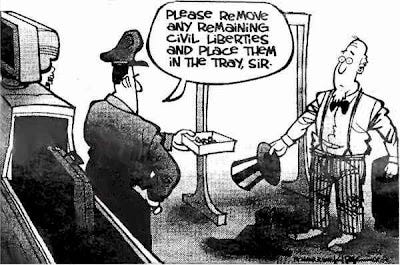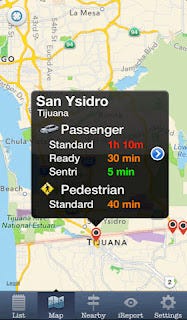DHS will scan (spy on) Americans payment cards at borders & airports.

Travelers leaving or entering the United States have long had to declare aggregated cash and other monetary instruments exceeding $10,000. Now, under a proposed amendment to the Bank Secrecy Act, FinCEN (Financial Crimes Enforcement Network) will also require travelers to declare the value of prepaid cards that they are carrying, known now as “tangible prepaid access devices.”
Expected to be finalized by the end of this year, the cross-border reporting modifications stem from a broader October 2011 definition of payment methods and form factors that replaced the term “stored value” with the term “prepaid access” in an effort to more accurately describe the process of accessing funds held by a payment provider.
Enforceability falls to U.S. Immigration and Customs Enforcement and U.S. Customs and Border Protection both within the Department of Homeland Security, which is already developing advanced handheld card readers that can ascertain whether a traveler is carrying a credit card, debit card, or prepaid card. This differentiation is important because only prepaid card balances will need to be added to declaration report forms.
Acknowledging that many questions still remain and that enforcement may not be straightforward, Cynthia Merritt, assistant director of the Retail Payments Risk Forum at the Federal Reserve Bank of Atlanta, had this to say about the handheld readers:
Furthermore, according to the comments, the enforcement challenge is not new, nor is the concept of a device or document that can be used to access value. The current challenges are similar to those presented in the past with other monetary instruments such as checks, money orders, and traveler checks.
Merritt also stated that, “When law enforcement takes possession of a cash or monetary instrument at the border, they are effectively holding the funds, but not so with a prepaid card or other device. Holding the card does not provide access to the underlying funds.”
Other questions to be settled include how to determine mobile phone wallet and key fob balances that can function in a manner similar to card swiping, how to distinguish between reloadable and non-reloadable prepaid cards, how to distinguish between bank-issued and non-bank-issued prepaid cards, should closed loop gift cards be included in the cross-border reporting requirements, what to do about cards that clear customs with a minimal balance but are then subsequently reloaded with an amount in violation of the reportable limits, and what to do about a large number of nonpersonalized, unembossed cards.
Also, would a traveler have legal recourse for damages if agents seized a proper debit card in the mistaken belief that it was a reportable prepaid card?
These complications and others imply that FinCEN’s NPRM [Notice of Proposed Rule Making] may yet undergo some revisions in order to bring the regulations in sync with the realities of the prepaid card industry.
http://www.forbes.com/sites/jonmatonis/2012/11/07/department-of-homeland-security-to-scan-payment-cards-at-borders-and-airports/
iPhone app lets border crossers determine best time to cross U.S. border.

Excessive border waits cause $2.5 billion in losses annually to the San Diego regional economy, with typical two-hour delays for trucks at commercial crossings into San Diego County costing the county $455 million in annual revenue from reduced freight activity; new “crowdsourced” information app allows motorists to decide the best time to cross the border by car or truck; the app’s information is meshed with the data on wait times at the border from U.S. Customs and Border Protection (CBP) to improve the accuracy of the wait times.
Next time you drive into the United States from Mexico or Canada, you may want to open a new iPhone app and provide an eyewitness account of how long you have to wait. This “crowdsourced” information will then be made instantly available to other motorists and help future border crossers to decide the best time to cross the border by car or truck. This iReport data is meshed with the data on wait times at the border from U.S. Customs and Border Protection (CBP) to improve the accuracy of the wait times.
The new “Best Time to Cross the Border” mobile app is now available in the Apple App store on iTunes.
“It includes all of the features first made available to Android app users last April, and in addition, the crowdsourcing component called iReport is also available on the iPhone,” said Ganz Chockalingam, principal development engineer in the California Institute for Telecommunications and Information Technology (Calit2), which publishes both apps, as well as California Wireless Traffic Report apps for iPhone and Android.
“Only commuters who are physically near a port can report wait times for that port,” added Chockalingam. “The app has only been available for a few days, and already commuters have started using this feature and we’ve been collecting user reported wait time data.”
A University of California, San Diego release reports that Chockalingam oversaw a team of graduate and undergraduate students from UC San Diego’s Computer Science and Engineering department, who built the iPhone app, including the crowdsourcing feature that allows commuters to report wait times. They included senior Matthew Davis and junior Rodrigo Rallo, and Master’s student Tarfah Alrashed. Tarfah is also a researcher at King Abdulaziz City of Science and Technology (KACST), a government research lab in Riyadh, Saudi Arabia. Mike Chiu, who is a programmer analyst at Calit2, developed the Web portal.
According to Calit2’s Chockalingam, crowdsourcing information from a cross-section of people crossing the border adds an important extra dimension to supplement the survey that often seemed to differ from the actual wait times. “Crowdsourcing should eliminate the problems that the border patrol has been having with regards to the accuracy of the wait times,” he noted. “We might be able to solve this problem without having to build or deploy any new infrastructure.”
Officials have considered adding more cameras to high-traffic border checkpoints, as well as computer-vision software to automatically capture and calculate how long each car takes to get from the back of the queue to entering U.S. territory. Crowdsourcing, however, offers a way to supplement survey data at no additional cost as long as commuters find the app inviting to use.
“Best Time to Cross the Border” is a service launched last April on the Internet and as a mobile app for Android users (via the Android Market or Google Play here). The updated Android version also supports the iReport feature. Very soon, users will also be able to report wait times via the mobile Web.
http://www.homelandsecuritynewswire.com/dr20121109-iphone-app-lets-border-crossers-determine-best-time-to-cross-u-s-border


